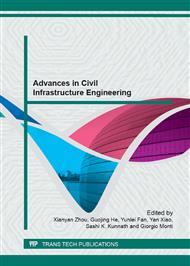[1]
Zube, E. Compaction Studies of Asphalt Concrete Pavement as Related to the Water Permeability Test, 41st Annual Meeting of the Highway Research Board, Washington, DC. (1962)
Google Scholar
[2]
Santucci, L.E., Allen, D.D. and Coats, R.L. The Effects of Moisture and Compaction on the Quality of Asphalt Pavements, Association of Asphalt Paving Technologists, Volume 54, (1985)
Google Scholar
[3]
Huber, G. A. and G. H. Heiman. "Effect of Asphalt Concrete Parameter on Rutting Performance: A Field Investigation", Association of Asphalt paving Technologists, Volume 56, pp.33-61, (1987)
Google Scholar
[4]
Ford, M. C. Pavement Densification Related to Asphalt Mix Characteristics, Paper presented at the 1988 Annual Meeting of the Transportation Research Board, Washington, DC., (1988)
Google Scholar
[5]
Meegoda, J.N. and Chang, K.G. Modeling viscoelastic behavior of Hot Mix Asphalt (HMA) using discrete element methods, Proceedings of the Materials Engineering Conference, n804, 804-811, (1994)
Google Scholar
[6]
Kim, H. and Buttlar, W.G. Micro mechanical fracture modeling of asphalt mixture using the discrete element method, Geotechnical Special Publication, n 130-142, 209-223, (2005)
DOI: 10.1061/40776(155)17
Google Scholar
[7]
You, Z. and Buttlar, W.G. Application of Discrete Element Modeling Techniques to Predict the Complex Modulus of Asphalt-Aggregate Hollow Cylinders Subjected to Internal Pressure, Journal of the Transportation Research Board, Volume 1929, Pages 218-226, (2005)
DOI: 10.1177/0361198105192900126
Google Scholar
[8]
You, Z., Adhikari, S., Kutay, M.E. Dynamic modulus simulation of the asphalt concrete using the X-ray computed tomography images, Materials and Structures, 42:617–630, (2009)
DOI: 10.1617/s11527-008-9408-4
Google Scholar
[9]
Dai, Q.and You, Z. Prediction of Creep Stiffness of Asphalt Mixture with Micromechanical Finite-Element and Discrete-Element Models, Journal of Engineering Mechanics, Vol. 133, No. 2, February 1, (2007)
DOI: 10.1061/(asce)0733-9399(2007)133:2(163)
Google Scholar
[10]
Abbas, A. et al. Micromechanical modeling of the viscoelastic behavior of asphalt mixtures using the discrete-element method, International Journal of Geomechanics, vol. 7, no. 2, pp.131-139, (2007)
DOI: 10.1061/(asce)1532-3641(2007)7:2(131)
Google Scholar
[11]
Wang, L.B. et al. Fundamental mechanics of asphalt compaction through FEM and DEM modeling, Geotechnical Special Publication, n176, pp.45-63, (2007)
Google Scholar
[12]
Itasca Consulting Group. PFC2D manual Ver.3.1, Minneapolis, (2004)
Google Scholar
[13]
Abbas, A. Simulation of the micromechanical behavior of asphalt mixtures using the discrete element method, PhD Dissertation of Washington State University, (2004)
Google Scholar
[14]
Liu, Y., Dai, Q. and You, Z. Viscoelastic Model for Discrete Element Simulation of Asphalt Mixtures, Journal of Engineering Mechanics, 324-333, (2009)
DOI: 10.1061/(asce)0733-9399(2009)135:4(324)
Google Scholar
[15]
Masad, E. et al. Quantifying Laboratory Compaction Effects on the Internal Structure of Asphalt Concrete, Transportation Research Record 1681, pp.179-185, (1999)
DOI: 10.3141/1681-21
Google Scholar
[16]
Masad, E. et al. Characterization of Air Void Distribution in Asphalt Mixes using X-ray Computed Tomography, J. Mat. in Civ. Engrg., Volume 14, Issue 2, pp.122-129, (2002)
DOI: 10.1061/(asce)0899-1561(2002)14:2(122)
Google Scholar
[17]
Tashman, L., et al. X-Ray Tomography to Characterize Air Void Distribution in Superpave Gyratory-Compacted Specimens, International Journal of Pavement Engineering, Volume 3, Issue 1, pages 19-28, (2002)
DOI: 10.1080/10298430290029902a
Google Scholar
[18]
Thyagarajana, S. et al. The heterogeneity and mechanical response of hot mix asphalt laboratory specimens, International Journal of Pavement Engineering, Vol. 11, No. 2, p.107–121, (2010)
DOI: 10.1080/10298430902730521
Google Scholar
[19]
Roberts, F.L. et al. Hot mix asphalt materials, mixture design, and construction, second edition, National Center for Asphalt Technology, (1996)
Google Scholar
[20]
Vavrik, W. R. et al. Bailey Method for Gradation Selection in HMA Mixture Design, Transp. Res. Circ., E-C044 . 2002.
Google Scholar
[21]
Bernal J.D, Proc. R. Soc. A 280 299-322, (1964)
Google Scholar
[22]
Sebastian Lobo-Guerrero et al., Visualization of Crushing Evolution in Granular Materials under Compression Using DEM, International Journal of Geomechanics, Vol. 6, No.3, (2006)
DOI: 10.1061/(asce)1532-3641(2006)6:3(195)
Google Scholar
[23]
Vallejo, L.E. Vallejo et al., Degradation of a Granular Base under a Flexible Pavement: DEM Simulation, Technical Note, International Journal of Geomechanics, Vol. 6, No. 6, (2006)
DOI: 10.1061/(asce)1532-3641(2006)6:6(435)
Google Scholar


